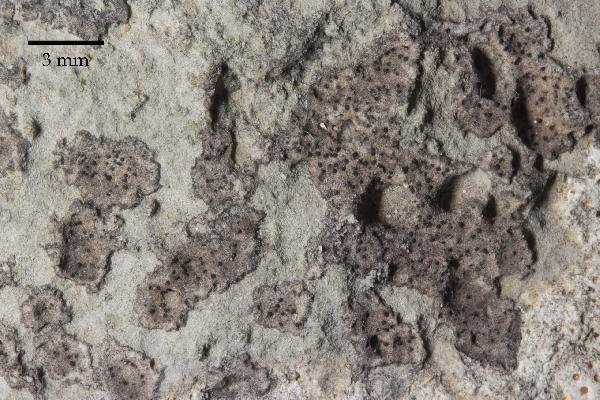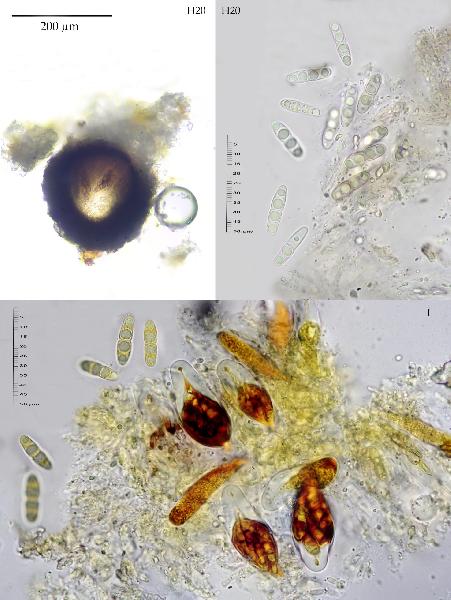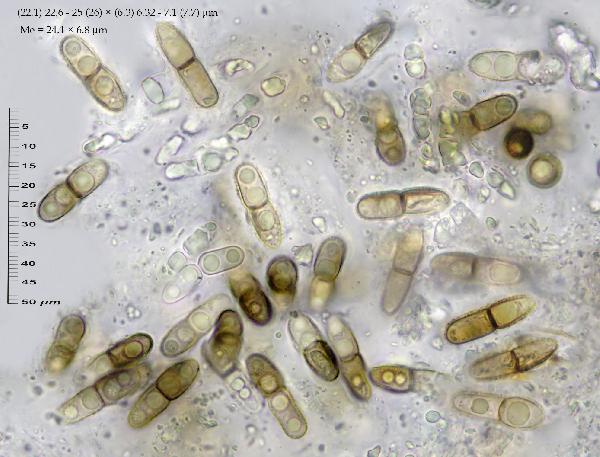Naetrocymbe saxicola (A. Massal.) R.C. Harris
More Florida Lichens: 63, 1995. Basionym: Arthopyrenia saxicola A. Massal. - Symmicta Lich.: 107, 1855.
Synonyms: Leiophloea saxicola (A. Massal.) Riedl; Naetrocymbe massalongiana (Hepp) R.C. Harris; Pyrenocollema saxicola (A. Massal.) Coppins; Sagedia massalongiana Hepp; Spermatodium saxicola (A. Massal.) Trevis.
Distribution: N - Frl (Tretiach 2004), Ven (Lazzarin 2000b, Roux 2009), TAA (Roux 2009, Nascimbene & al. 2022), Lomb, Piem (Isocrono & al. 2004). C - Mol (Nimis & Tretiach 1999, Caporale & al. 2008). S - Camp (Garofalo & al. 1999), Pugl.
Description: Thallus crustose, endosubstratic or thinly episubstratic, brownish to pinkish grey, often minutely mottled, becoming almost black when wet, lichenized. Perithecia black, 0.1-0.2 mm across, globose, half to almost completely immersed in pits in the rock, the apex convex or somewhat flattened. Upper part of exciple strongly thickened, composed of dark brown, very thick-walled cells; involucrellum hardly distinguishable from the thickened upper part of exciple; hamathecium of irregular, richly branched and anastmosing, very thin-walled, 2-2.5 µm thick, finally gelatinized pseudoparaphyses. Asci 8-spored, obpyriform, fissitunicate, with two functional wall layers, with a distinctive apical region lacking a nasse, I-, containing biseriately arranged spores, (49-)75-100 x (11.5-)18-25 µm. Ascospores 1-septate, slightly constricted at septum, hyaline, cylindrical-ellipsoid to slightly clavate, 18-24(-28) x 4-5(-8) µm, the upper cell only slightly broader than the other, surrounded by a thin perispore; overmature spores turning brown, finely rugulose, sometimes thinly 3-septate. Pycnidia frequent, black, half-immersed, with a rather large ostiole. Conidia simple, hyaline, bacilliform, 4-5 x 0.5-1.2 µm. Photobiont trentepohlioid. Spot tests: thallus K-, C-, KC-, P-, UV-. Chemistry: without lichen substances.Note: an early coloniser of calcareous rocks, especially at the top of boulders, on surfaces which rapidly dry out after rain. According to Roux (2009), this species is clearly lichenised with Trentepohlia.
Growth form: Crustose endolithic
Substrata: rocks
Photobiont: Trentepohlia
Reproductive strategy: mainly sexual
Pioneer species
Commonnes-rarity: (info)
Alpine belt: absent
Subalpine belt: very rare
Oromediterranean belt: rare
Montane belt: rare
Submediterranean belt: absent
Padanian area: absent
Humid submediterranean belt: absent
Humid mediterranean belt: absent
Dry mediterranean belt: absent

Predictive model
Herbarium samples

Marta Gonzalez Garcia - Centro de Estudios Micologicos Asturianos
Spain, Capilla del Alba, Salcedo (Quirós-Asturias), 22-XII-2022, en rocas calizas, leg. & det. M. González, junto a Protoblastenia incrustans (DC.) J.Steiner

Marta Gonzalez Garcia - Centro de Estudios Micologicos Asturianos
Spain, Capilla del Alba, Salcedo (Quirós-Asturias), 22-XII-2022, en rocas calizas, leg. & det. M. González, junto a Protoblastenia incrustans (DC.) J.Steiner

Marta Gonzalez Garcia - Centro de Estudios Micologicos Asturianos
Spain, Capilla del Alba, Salcedo (Quirós-Asturias), 22-XII-2022, en rocas calizas, leg. & det. M. González, junto a Protoblastenia incrustans (DC.) J.Steiner

Photo uploaded by P. Cannon - CC BY-SA NC - Source: http://fungi.myspecies.info/sites/fungi.myspecies.info/files/A12255.jpg

Photo uploaded by P. Cannon - CC BY-SA NC - Source: http://fungi.myspecies.info/sites/fungi.myspecies.info/files/A12255.jpg

Collezione lichenologica Abramo Massalongo del Museo di Storia Naturale G. Ligabue di Venezia - Autori: Seggi, Linda; Trabucco, Raffaella Proprietà: Fondazione Musei Civici di Venezia - CC BY-NC
Italy, Veneto, (cum Amphoridio galactino Massal. in A.) L. in op. Velo
as Arthopyrenia saxicola - ISOTYPE

Source: Keissler K. von 1938. Pyrenulaceae, Mycoporaceae, Coniocarpineae. In: Rabenhorst G L: Kryptogamen-Flora von Deutschland, Österreich und der Schweiz. 2nd, IX, Die Flechten, Abt. 1, 2. Gebr. Borntraeger, Leipzig, pp. 1-846.
Growth form: Crustose endolithic
Substrata: rocks
Photobiont: Trentepohlia
Reproductive strategy: mainly sexual
Pioneer species
Commonnes-rarity: (info)
Alpine belt: absent
Subalpine belt: very rare
Oromediterranean belt: rare
Montane belt: rare
Submediterranean belt: absent
Padanian area: absent
Humid submediterranean belt: absent
Humid mediterranean belt: absent
Dry mediterranean belt: absent

Predictive model
| Herbarium samples |

Marta Gonzalez Garcia - Centro de Estudios Micologicos Asturianos
Spain, Capilla del Alba, Salcedo (Quirós-Asturias), 22-XII-2022, en rocas calizas, leg. & det. M. González, junto a Protoblastenia incrustans (DC.) J.Steiner

Marta Gonzalez Garcia - Centro de Estudios Micologicos Asturianos
Spain, Capilla del Alba, Salcedo (Quirós-Asturias), 22-XII-2022, en rocas calizas, leg. & det. M. González, junto a Protoblastenia incrustans (DC.) J.Steiner

Marta Gonzalez Garcia - Centro de Estudios Micologicos Asturianos
Spain, Capilla del Alba, Salcedo (Quirós-Asturias), 22-XII-2022, en rocas calizas, leg. & det. M. González, junto a Protoblastenia incrustans (DC.) J.Steiner

Photo uploaded by P. Cannon - CC BY-SA NC - Source: http://fungi.myspecies.info/sites/fungi.myspecies.info/files/A12255.jpg

Photo uploaded by P. Cannon - CC BY-SA NC - Source: http://fungi.myspecies.info/sites/fungi.myspecies.info/files/A12255.jpg

Collezione lichenologica Abramo Massalongo del Museo di Storia Naturale G. Ligabue di Venezia - Autori: Seggi, Linda; Trabucco, Raffaella Proprietà: Fondazione Musei Civici di Venezia - CC BY-NC
Italy, Veneto, (cum Amphoridio galactino Massal. in A.) L. in op. Velo
as Arthopyrenia saxicola - ISOTYPE

 INDEX FUNGORUM
INDEX FUNGORUM
 GBIF
GBIF
 DOLICHENS
DOLICHENS






